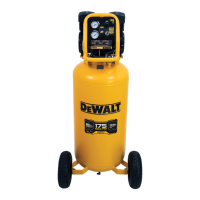
Do you have a question about the DeWalt DXCMSAC260 and is the answer not in the manual?
| Brand | DeWalt |
|---|---|
| Model | DXCMSAC260 |
| Category | Air Compressor |
| Language | English |
Indicates the compressor uses an oil-free lubrication system.
Motor directly drives the pump without belts or gears.
Specifies air output at 4.0 SCFM at 90 PSI.
Operating voltage requirement is single-phase 120V.
Specifies a minimum 15A branch circuit is needed.
Requires a time delay fuse for operation.
Indicates imminently hazardous situation, potentially leading to death or serious injury.
Indicates potentially hazardous situation, could result in death or serious injury.
Indicates potentially hazardous situation, may result in minor or moderate injury.
Indicates practice not related to personal injury, may result in property damage.
Essential to read manual for safety, operation, and maintenance before using.
Warns about lead content, potential harm if ingested, and dust generation.
Alerts to exposure to chemicals like lead, known to cause cancer or birth defects.
Sparks can ignite flammable vapors; ensure proper ventilation.
Restricting ventilation causes overheating; unattended use is hazardous.
Always attend unit when operating and power off when not in use.
Compressed air can contain contaminants; be aware of chemical exposure.
Use compressor air only for tools, not breathing; ensure ventilation and wear protection.
Failure to drain water causes rust and thinning of the steel air tank.
Never drill, weld, or modify the air tank; replace if damaged.
Modifying safety valve or pressure controls voids safety.
Exceeding pressure ratings of tools/accessories can cause explosions.
Over-inflation of tires can cause injury or property damage.
Use a gauge to check tire pressure during inflation.
Air stream can cause tissue damage and propel objects at high speed.
Wear eye protection, point nozzles safely, and bleed pressure before maintenance.
Touching exposed hot metal parts can cause burns; allow unit to cool.
Ground unit properly; avoid unqualified repairs and electrical hazards.
Follow installation guidelines, use protective covers, and avoid outdoor/wet operation.
Understand manual and controls before operating.
Keep area clear, keep children away, and ensure fire extinguisher is available.
Do not operate when fatigued or under influence; stay alert.
Maintain safety features, use correct parts, and do not stand on unit.
Avoid contact with moving parts; keep guards intact and clear vents.
All repairs must be performed by DEWALT service centers.
Compressor is heavy; obtain assistance before lifting to prevent injury.
Noise may cause hearing loss; always wear certified hearing protection.
Read manual and safety rules; familiarize yourself with controls.
Identifies key parts: switches, gauges, valves, filter, regulator, and connect body.
Unpack unit, inspect for damage, and check contents against the manual.
Instructions for attaching the wheels to the compressor unit.
Instructions for attaching the front bumpers to the compressor unit.
Grasp hose firmly to prevent whip when installing or disconnecting.
Oilless compressors are factory lubricated for life and require no oil.
Use compatible tools; employ filters for moisture/oil removal.
Place in clean, dry, ventilated area, 12" from obstructions, near power.
Use qualified electrician for installation to avoid warranty voidance.
Product must be grounded with a proper plug and outlet.
Identify ground wire; consult electrician if unsure about installation.
Use grounded, 12 AWG+ cords; avoid undersized cords.
Ensure adequate circuit capacity, voltage, and fuse protection.
Details conditions for 15A circuit operation including dedicated circuit and fuse type.
Set the Auto/Off switch to "Off (O)" to stop the unit.
Read manual, ensure switch is off, plug in, open drain valve.
Run compressor for 15 mins, check leaks, then complete shutdown and restart.
Check switch, drain valve, lines, safety valve, and set regulator to zero.
Turn Auto/Off to Auto, let pressure build, then adjust regulator.
Be aware of noise/vibration; stop unit if unusual issues occur.
Turn off unit, set regulator to zero, remove accessories, drain tank, clean, store, unplug.
Drain tank daily to prevent corrosion and potential rupture.
Schedule for daily, weekly, monthly, and annual checks of components.
Pull ring to ensure valve operates freely; replace if stuck or faulty.
Ensure switch is off, unit is cool, then remove and clean/replace filter.
Follow steps to drain tank, including safety valve use and regulator setting.
Prevent corrosion/rupture by draining daily; dispose condensate properly.
Annual check of pump intake/exhaust valves by a technician is recommended.
Inspect air lines and fittings for leaks using soap solution; correct any found.
All repairs not listed must be done by trained technicians.
Unplug, bleed pressure, and cool unit before servicing.
Avoid unauthorized service; use only recommended accessories.
Have model, serial, and purchase details ready for service inquiries.
Ensure repairs are done by DEWALT centers using identical parts.
1 Year limited on oil-free compressors; covers defects in materials/workmanship.
Excludes damage from misuse, neglect, unauthorized repairs, and normal wear items.
Covers parts and labor for defects in the first year of ownership.
Owner must install, maintain, and operate per manual; routine maintenance is owner's responsibility.
Lists warranty periods for separately purchased parts like pumps and motors.
Requires original purchaser proof of purchase and delivery of unit to Authorized Service Center.
Contact for free replacement if warning labels are missing or illegible.
Defines terms like CFM, SCFM, PSI, cut-in/cut-out pressure, well-ventilated, etc.
Covers leaks, insufficient air, and restricted intake.
Addresses current draw, cold start issues, and voltage.
Deals with pressure drops, regulator leaks, and pressure build-up.
Covers stalls, overheating, and other operational malfunctions.
Addresses leaks, tank defects, seals, and safety valve issues.
Covers air usage, compressor capacity, hose issues, environment, and intake filters.
Addresses duty cycles, piston rings, cylinder/piston damage, and cylinder finish.
Covers regulator adjustment, damage, and openness.
Addresses voltage, overload, passages, low voltage motor, check valve, and seized pump.
Covers ventilation, cooling, back pressure, and cold temperature issues.
